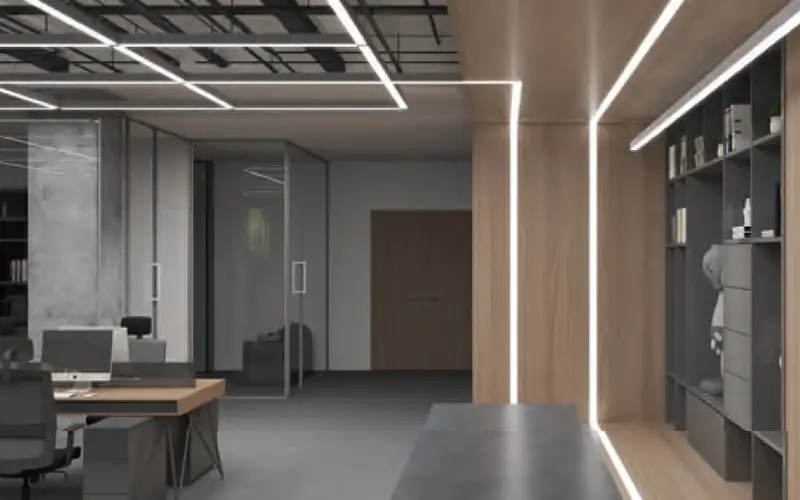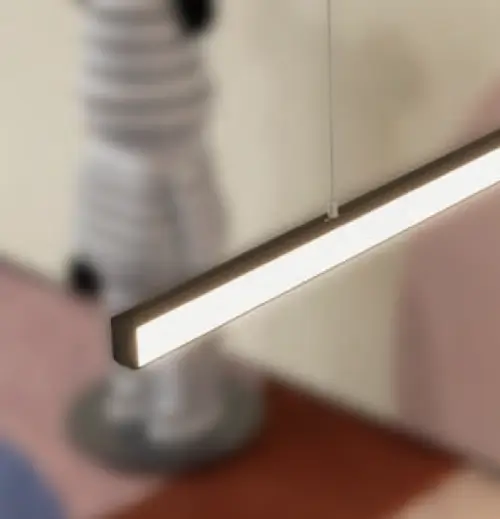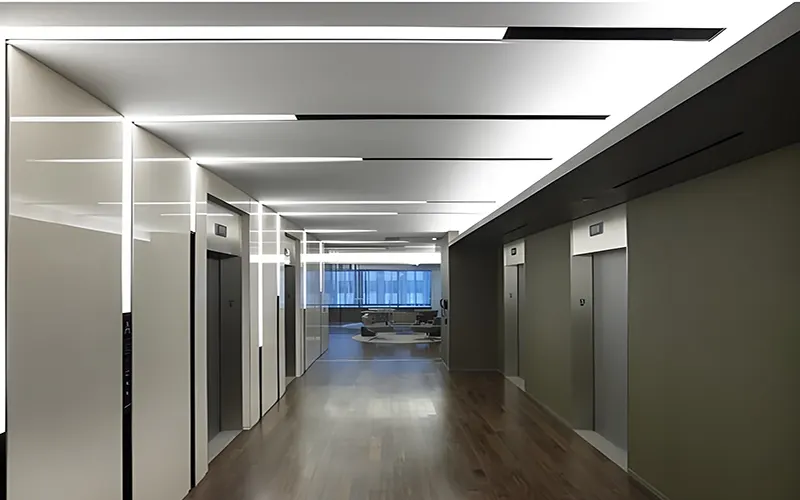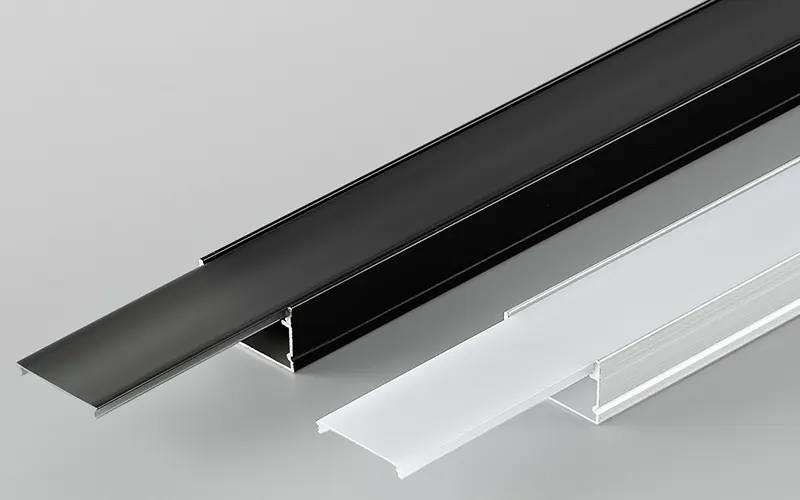
In lighting projects, LED aluminum channel can add functionality and appearance to your lighting projects. These channels not only enhance the look of your lighting setup, but they also provide many practical benefits. Aluminum extrusions are compatible with LED strips of any color and color temperature. In this guide, we will take an in-depth look at LED aluminum channel.
What are the Typical Types of LED Strip Aluminum Channel?
LED aluminum channel come in various shapes and sizes designed to fit different installation needs and preferences. The most common types include: More details, pls read How Many Types of LED Channels Are There?
- Surface Mount Channels: These channels mount directly onto a flat surface, such as a wall, ceiling, or under a cabinet. They offer a sleek, modern look and are often used to illuminate areas that are both functional and decorative.
- Flush Channels: Flush profiles are recessed into the surface, allowing them to sit nearly flush with the wall or ceiling. They offer a clean, minimalist look that is perfect for high-end residential or commercial applications.
- Corner Channels: Corner channels are designed for right-angle mounting, making them ideal for lighting narrow spaces, such as the edge of a wall, under a cabinet, or along a staircase.
- Suspended Channels: Suspended LED channels are suspended from the ceiling and are often used in commercial settings or modern residential environments. They provide ambient lighting while also being a design feature.
- Freeform Bend Channels: Designed for curved or irregular surfaces, these channels offer the versatility to accommodate unique architectural features.
Each type of channel serves a specific purpose, ensuring that the lighting not only complements the space, but also enhances the overall design aesthetic. More information, pls read 2024 Ultimate Guide for LED Aluminum Profile
Do Aluminum LED Channel Help Dissipate Heat?
One of the main reasons for using aluminum channels and LED strips is to dissipate heat. Aluminum profiles can help reduce the amount of heat generated by the LED strip when it is in operation.
Aluminum channel is a metal that has excellent thermal conductivity and reflectivity, making it ideal for heat management and heat dissipation. While LED lights are known for being energy efficient and having lower heat output compared to traditional lighting, they still generate some heat during operation. Over time, excess heat can damage the LED, shorten its lifespan, and cause inconsistent lighting.
Known for its excellent thermal conductivity, aluminum acts as a heat sink in LED profiles. The heat generated by the LED strip is transferred to the aluminum channel, which then disperses it into the surrounding air.
This prevents the LED from overheating, ensuring optimal performance and lifespan. The sturdier the profile, the better the heat dissipation, making aluminum LED channels essential for high-density or high-power LED strip installations.
Why Choose LED Aluminum Channel?
There are several compelling reasons to choose LED aluminum channel for your LED strip installation:
- Enhanced Aesthetics: Aluminum channels provide a stylish, professional finish to LED light strip installations. Whether surface or flush mounted, they conceal wiring and light strips, giving the installation a more sophisticated look.
- Improved Light Diffusion: Most LED aluminum profiles come with diffuser covers that soften the light and reduce glare. This creates a more even lighting effect, eliminating the harshness sometimes associated with LED light strips.
- Protect LEDs: The profiles and their diffusers protect LED light strips from dust, moisture, and physical damage. This is especially helpful in environments where the lights are exposed to high traffic or harsher conditions.
- Customizable Lighting Solutions: Aluminum profiles are available in a variety of shapes and designs, allowing you to create a customized lighting solution for your specific space or design preference.
- Extended LED Life: The heat dissipation properties of aluminum profiles prevent LEDs from overheating, thereby extending their life.
When are LED Aluminum Channels Not Needed?
While LED aluminum profiles offer many benefits, they are not required for every lighting project. In some cases, the additional cost and complexity of installing the channels may not be justified. Here are some scenarios where LED aluminum channels may not be needed:
- Temporary installation: If the LED light strip is used for a short-term project or temporary event, then the use of aluminum profiles may not be necessary. In these cases, a basic mounting solution will suffice.
- Low-heat, low-power LEDs: Some low-output or decorative LED light strips generate minimal heat and may not require the additional protection or heat dissipation provided by aluminum channels.
- Concealed installation: If the LED light strip is completely hidden, such as behind a recessed area or in a recessed area where the profile is not visible, aluminum channels may not be required for aesthetic reasons.
LED Aluminum Channel vs. COB LED Strips
COB LED light strips are a relatively innovation in LED technology that provide a continuous, spotless lighting effect, unlike traditional LED light strips. When comparing LED aluminum profiles and COB LED strips, it’s crucial to understand their differences in application and appearance:
- Light Quality: COB LED strips emit smooth, uniform light with no visible dots, making them ideal for applications that require a continuous light source. Traditional LED strips, on the other hand, often display individual dots of light unless diffused by a profile cover.
- Heat Dissipation: While COB LEDs are more efficient at thermal management due to their structure, they can still benefit from being mounted in aluminum channels, especially in high-power applications.
- Durability and Protection: Like regular LED strips, COB LEDs can be fragile and easily damaged by dust or impact. Using an aluminum channel protects them and extends their lifespan, whether their light output is smooth or not.
What Makes a Quality LED Aluminum Channel?
While COB LED strips offer a more refined lighting experience, pairing them with aluminum profiles ensures longer life, heat management, and protection. We’ve already discussed the benefits of aluminum channels for luminaires. Next, let’s take a deeper look at what factors contribute to the quality and performance of LED channels.
Aluminum Profiles
- The best aluminum alloy for LED profiles is 6063-T5.
- In general, the thicker the aluminum profile, the better the heat dissipation. However, thicker profiles also mean higher costs.
- In addition, the anodized layer of aluminum profiles should reach 8-13 microns. The thicker aluminum oxide surface layer not only prevents deformation but also provides greater corrosion resistance.
High-quality Diffusers
Using a high-quality diffuser ensures the performance and life of the LED channel. When choosing a diffuser, keep in mind the following points:
- The thickness of the ultra-thin cover should be 1.2 mm.
- The thickness of the large cover should be 1.5 mm.
- Raw material used for the diffuser should be strong and durable, avoid using covers made from recycled materials as they are often not strong enough and will age easily.
The quality diffusers we offer are made from top-quality raw materials and ensure that each product meets the correct specifications to ensure its performance and durability.

How to Ensure LED Strip Light Aluminum Channel Compatibility?
Before purchasing or installing an LED aluminum channel, it’s important to make sure it’s compatible with the LED strip lights you’ve chosen. Here are some tips to ensure a perfect match:
- Measure the LED Strip Light: Check the width and thickness of your LED strip lights and compare it to the interior dimensions of the channel. Make sure there’s enough room for the strip lights to fit comfortably inside the profile.
- Consider Diffuser Type: Some diffusers are designed for specific types of lights, so if you’re using COB LED strip lights or high-density strip lights. Make sure the diffuser will provide the desired lighting effects without dark spots or glare.
- Check Mounting Options: Depending on your installation, make sure the channel comes with the appropriate mounting hardware. Whether you need surface-mount clips, screws, or hanging wires, compatibility with the mounting surface is key.
- Heat Output: For high-output LED strip lights, choose thicker aluminum profiles to ensure better heat dissipation. If you’re unsure, consult the manufacturer to choose a channel that can handle the heat load of the LEDs.
By carefully matching your LED strips and aluminum channels. You can ensure a smooth installation and a long-lasting, professional lighting setup.
Conclusion
The LED aluminum channel is an important component to enhance the performance and appearance of your LED strips. Whether you want to improve heat dissipation, protect your lights, or simply use profiles for a more sophisticated look, understanding the differences between high-quality and low-quality profiles will help you make the right decision for your project. We are an LED profile factory, pls contact us if you need.




